Stink bug or stinkbug is a common name for several insects and may refer to:

Pentatomidae is a family of insects belonging to the order Hemiptera, generally called shield bugs or stink bugs. Pentatomidae is the largest family in the superfamily Pentatomoidea, and contains around 900 genera and over 4700 species. As hemipterans, the pentatomids have piercing sucking mouthparts, and most are phytophagous, including several species which are severe pests on agricultural crops. However, some species, particularly in the subfamily Asopinae, are predatory and may be considered beneficial.

Pentatominae is a subfamily of Pentatomidae, a family of shield bugs. This subfamily is the largest one within the Pentatomidae, having 4937 species classified in 938 genera. Species in this subfamily are phytophages and several of them are considered agricultural pests. Some invasive pentatomines such as Halyomorpha halys and Bagrada hilaris have been considered household pests. Higher systematics of the group have been revised by Rider et al.

The Pentatomomorpha comprise an infraorder of insects in the true bug order Hemiptera. It unites such animals as the stink bugs (Pentatomidae), flat bugs (Aradidae), seed bugs, etc. They are closely related to the Cimicomorpha.
Jumiles ;, are small stink bugs native to the Taxco region of the state of Guerrero in Mexico. Any edible Hemiptera from the families Coreidae or Pentatomidae may be considered jumiles as well. Their diet includes the leaves of the encina tree. Chumiles are a smaller, similar hemipteran of the same region. Both jumiles and chumiles are insects of the order Hemiptera and family Pentatomidae. Pentatomids are commonly called "stink bugs" in English. Both are used as food.
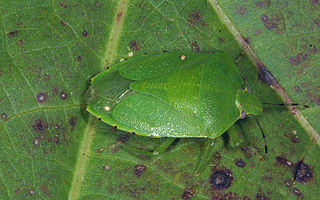
The green stink bug or green soldier bug is a stink bug of the family Pentatomidae.

The brown marmorated stink bug is an insect in the family Pentatomidae, native to China, Japan, Korea and other Asian regions. In September 1998 it was collected in Allentown, Pennsylvania, where it is believed to have been accidentally introduced. The nymphs and adults of the brown marmorated stink bug feed on over 100 species of plants, including many agricultural crops, and by 2010–11 had become a season-long pest in orchards in the Eastern United States. In 2010, in the Mid-Atlantic United States, $37 million in apple crops were lost, and some stone fruit growers lost more than 90% of their crops. It is now established in many parts of North America, and has recently become established in Europe and South America.
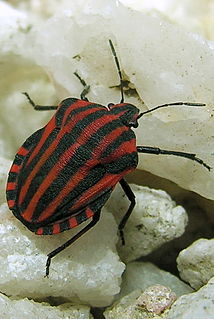
Graphosoma is a genus of the family Pentatomidae known as the striped shield bugs for their distinctive markings.

Apodiphus amygdali is a species of shield bug belonging to the family Pentatomidae, subfamily Pentatominae.

Carpocoris purpureipennis is a species of shield bug of the family Pentatomidae, subfamily Pentatominae.

Dyroderes umbraculatus is a shield bug belonging to the family Pentatomidae, subfamily Pentatominae. The species was first described by Johan Christian Fabricius in 1775.

Sciocoris sideritidis is a species of shield bug belonging to the family Pentatomidae, subfamily Pentatominae.

Carpocoris is a genus of shield bug in the family Pentatomidae. The species of this genus are quite similar.
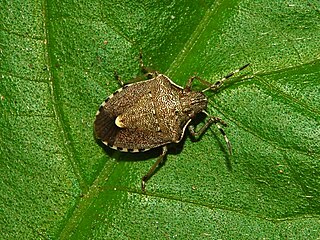
Holcostethus is a genus of shield bugs belonging to the family Pentatomidae, subfamily Pentatominae.
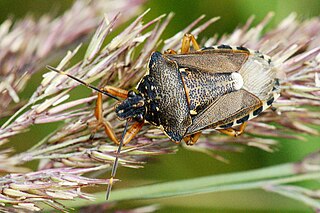
Pinthaeus sanguinipes is a species of stink bug.

The Dinidoridae are a small family of insects comprising about a hundred species in sixteen genera in the Hemipteran suborder Heteroptera, the "true bugs". As a group the family does not have any common name. Until the late 19th century they were generally regarded as a subfamily of the Pentatomidae.

Cosmopepla lintneriana, the twice-stabbed stink bug, locally called the wee harlequin bug, is a species of insect in the family Pentatomidae. Cosmopepla lintneriana was first described in 1798 by Johan Christian Fabricius as Cimex carnifex, and then again in 1865 by Thomas Say as Cosmopepla bimaculata. Cosmopepla lintneriana is hosted by a variety of plants, including milk thistle, echinacea, asparagus, oats, mint and goldenrod, and is widespread throughout North America, from Canada to Mexico. Adult C. lintneriana are black with a red, orange, or yellow band across the pronotum and a short red stripe along the midline, and two red spots at the apex of the scutellum. Nymph coloration ranges from red to white with black markings that change as they grow.
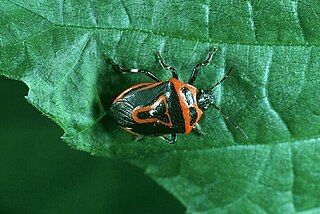
Perillus bioculatus, the two-spotted stink bug or double-eyed soldier bug, is a species of insect in the family Pentatomidae. They are native to North America but have been introduced to Eastern Europe and North India. Both the larval and adult stages are specialized predators of eggs and larvae of the Colorado potato beetle. However, the first instar larvae feed by sucking the juices out of potato stems.

Piezodorus guildinii, known generally as red-banded stink bug, is a species of stink bug in the family Pentatomidae. Other common names include the small green stink bug and alfalfa bug.
Megarididae is a family of true bugs in the superfamily Pentatomoidea. The family consists of a single extant genus Megaris with about 16 species restricted to the Neotropical Realm and a fossil is known from Dominican amber.
















